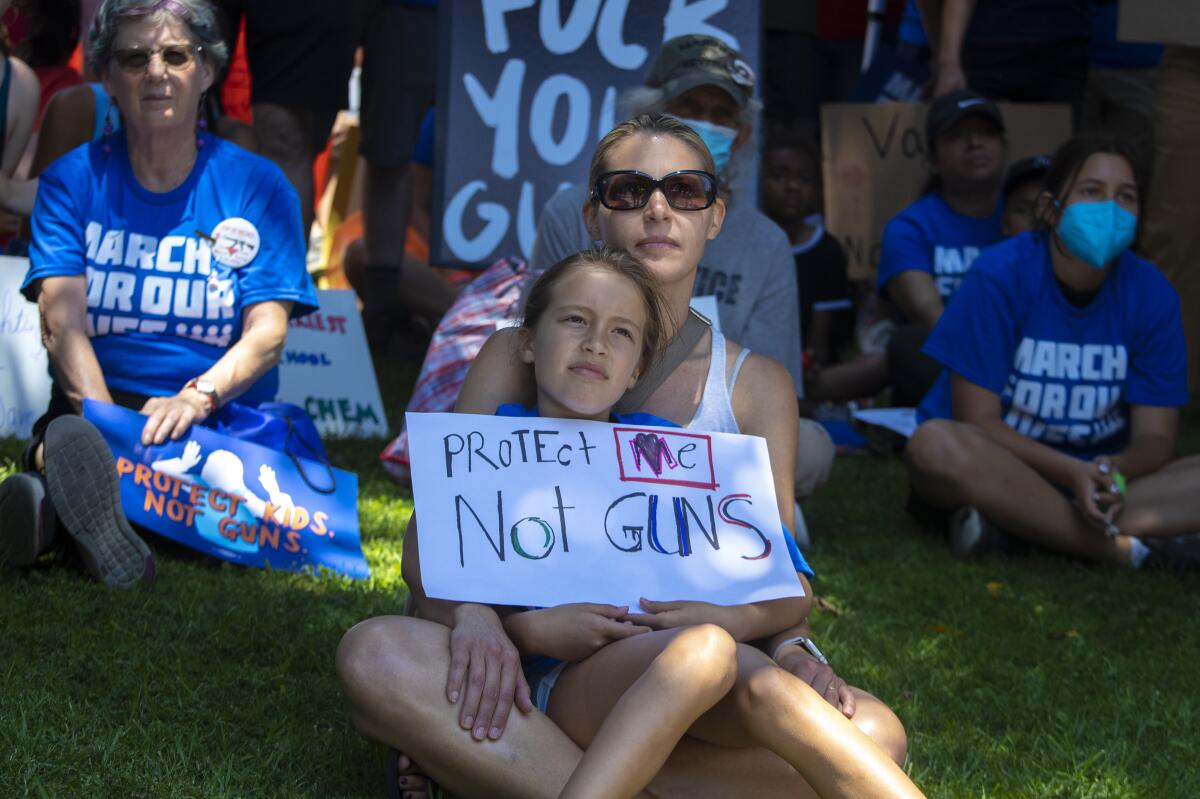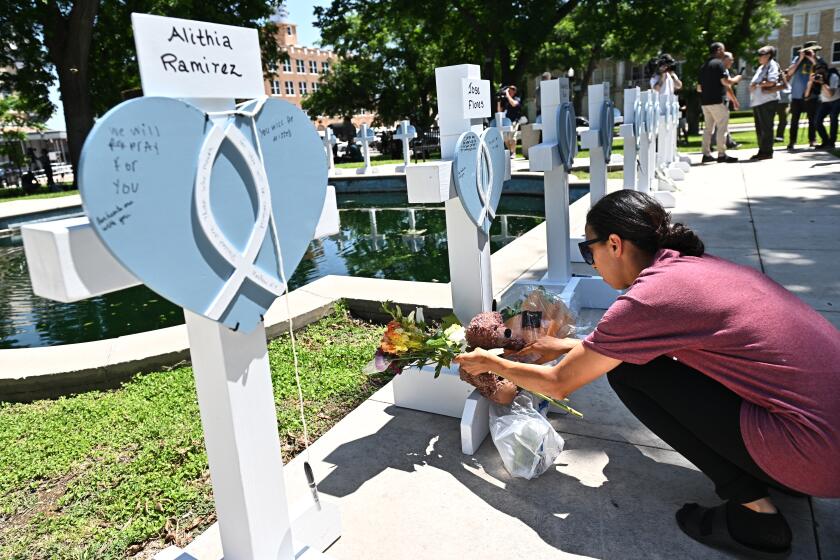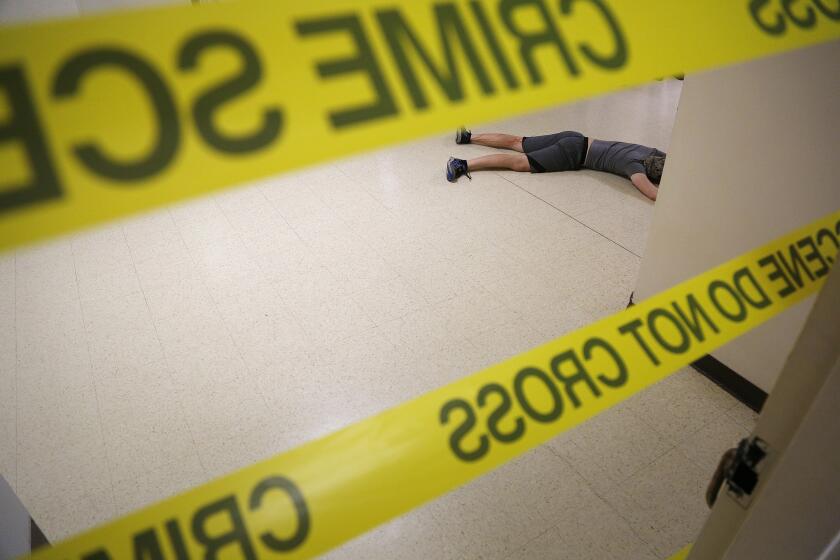Commentary: On gun control, young people might be our last hope

- Share via
Anna Pham is not your typical activist. At just 11 years old, she became passionate about gun control after the mass shooting at Marjory Stoneman Douglas High School in 2018. Joining other teens in March for Our Lives, a national student-led movement against gun violence, Anna turned to activism because she was “tired of seeing my representatives not doing anything and just tweeting.”
Now a rising junior at Murrieta Valley High School, Anna has led crowds of up to 8,000 protesters demanding gun safety reform — and she’s part of a generation that may be our last hope for meaningful change.
For the record:
4:23 p.m. July 6, 2022An earlier version of this article incorrectly reported that Zaineh Saleh organized a walkout after a school bus was shot with a BB gun. The walkout occurred after the mass shooting in Uvalde, Texas.
Anna said the failure to prevent recent gun violence is a result of politicians’ inaction. “We elect them to represent us and protect us and serve us,” Anna said. “For the past few years, they’ve clearly seen the outcry of public opinion, and how we are honestly tired of children dying, family members dying or our neighbors dying.”
Anna’s frustration is no surprise after the carnage of this year’s shootings in Uvalde, Texas, and Buffalo, N.Y. Teenagers like her are growing up in an age in which such brutalities — among more than 256 mass shootings just this year — are a regular byproduct of American life. Polls show a majority of American teenagers worry about school shootings, and for good reason: More than 800 children and teens have been killed in firearm-related incidents so far this year.
“It’s almost a part of the universal American high school experience to be very jumpy at anything that could resemble a threat to gun violence, whether that is a concerning post on social media, or even a sound at school that resembles a gunshot,” Nick Nyein, a recent graduate of Golden Valley High School in Santa Clarita, told me.
Resisting gun control is one of the many ways our country’s leaders tolerate violence against children whom they have the power and responsibility to protect.
American children are also especially vulnerable to bloodshed compared with those in similarly wealthy countries. The chance that a U.S. child dies from a firearm is 36 times higher than other high-income countries. In 2020, firearms surpassed car crashes as the leading cause of death for U.S. children and adolescents. “Even when I’m in public, I’m still under this constant threat of being a victim of gun violence … It just never ends in that, once again, this fear is gonna follow me,” Nick said.
But youth activists I talked to say they refuse to collapse under despair. They believe their demands can become political realities if more young people engage in political activism, whether through social media, petition signing or volunteering to boost voter registration.
“Everybody kind of knows this when they hear the term ‘activism,’ but not many understand that it can actually create change,” Anna said.
Since the shooting death of 17 students in Parkland, Fla., in 2018 and the subsequent rise of the March for Our Lives movement, students have been at the forefront of gun safety protests in the United States. Young activists have built massive social media followings and are registering people to vote on this issue.
Generation Z is not a monolith, but despite having the most anxiety about the future, it’s the generation most eager for change. “Many people my age are defined by a greater sense of political efficacy because they’ve grown up with organizations like March for Our Lives and so many young activists over the course of 2018 to 2022,” Nick said.
In 2018 alone, 67 gun safety bills were passed in 26 states and Washington, D.C., according to the Giffords Law Center to Prevent Gun Violence, in part because of student activism around the Parkland shooting and efforts of organizations such as Moms Demand Action. These efforts are resurging amid recent tragedies, with youth advocates forming grass-roots coalitions and confronting elected officials, including Florida Gov. Ron DeSantis.
During a school lockdown, you see the fear in your students’ eyes and you feel the fear in your own eyes even as you try to remain calm.
None of this is to say children should have to shoulder responsibilities that otherwise belong to elected officials.
“It’s pretty sad that my mother has to sit down and talk to my brother, who was a fifth-grader, and tell him what to do in case” of a shooting, Zaineh Saleh, a sophomore at Hollywood High School, told me. “We shouldn’t be telling small kids that there is a chance something like this might happen.”
Zaineh said that educating her peers is “the least I can do.” Zaineh is co-president of her school’s Students Demand Action chapter and helped organize a walkout for students after the mass shooting in Uvalde, Texas.
.
“The least we can do is show support that we are not OK with this,” Zaineh said. “We’ve received backlash, but ... that’s not a reason to stop.”
Anna said that after her protest, she was contacted by Los Angeles City Atty. Mike Feuer and the Los Angeles County Board of Supervisors to discuss expanding gun regulations. In the meantime, Anna is working to expand tool kits for hosting voter registration booths and step-by-step guides for people to join local rallies, town halls or contact their representatives.
“We’re not done yet,” Anna said. “It’s just the start.”
Last week, President Biden signed a landmark gun control measure that toughens background checks and funds mental health initiatives. But the new law fails to include two core demands of activists: universal background checks and a ban on assault weapons. A recent Supreme Court ruling that struck down a New York law restricting the carrying of handguns in public may make stricter gun regulations harder to achieve. But that doesn’t mean progress can’t be made.
If those in power won’t commit to ending gun violence, we must look to mass movements for change — and it’s only natural that high schoolers and college students are the ones spearheading them. They’re the ones inheriting the future. Their activism rings of antiwar resistance during the Vietnam War, where protests on college campuses helped shift public sentiment over time, and builds on a centuries-long tradition of student activism in the U.S.
It’s often after the stomping and shouting that powerful people finally listen to the young and disenfranchised.
More to Read
A cure for the common opinion
Get thought-provoking perspectives with our weekly newsletter.
You may occasionally receive promotional content from the Los Angeles Times.













